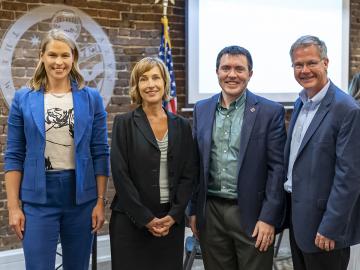
Filter News
Area of Research
- (-) Energy Science (82)
- (-) Supercomputing (85)
- Advanced Manufacturing (2)
- Biology and Environment (112)
- Biology and Soft Matter (1)
- Computational Biology (1)
- Computational Engineering (3)
- Computer Science (6)
- Electricity and Smart Grid (1)
- Energy Frontier Research Centers (1)
- Functional Materials for Energy (1)
- Fusion and Fission (10)
- Fusion Energy (8)
- Isotopes (2)
- Materials (70)
- Materials for Computing (12)
- Mathematics (1)
- National Security (27)
- Neutron Science (28)
- Nuclear Science and Technology (11)
- Nuclear Systems Modeling, Simulation and Validation (1)
- Quantum information Science (2)
- Sensors and Controls (1)
News Topics
- (-) Advanced Reactors (7)
- (-) Environment (69)
- (-) Machine Learning (20)
- (-) Mercury (3)
- (-) Microscopy (14)
- (-) Nanotechnology (15)
- (-) Security (10)
- (-) Statistics (1)
- (-) Summit (44)
- 3-D Printing/Advanced Manufacturing (81)
- Artificial Intelligence (42)
- Big Data (27)
- Bioenergy (29)
- Biology (19)
- Biomedical (22)
- Biotechnology (6)
- Buildings (39)
- Chemical Sciences (16)
- Clean Water (8)
- Composites (17)
- Computer Science (108)
- Coronavirus (25)
- Critical Materials (12)
- Cybersecurity (14)
- Energy Storage (74)
- Exascale Computing (27)
- Fossil Energy (2)
- Frontier (32)
- Fusion (2)
- Grid (41)
- High-Performance Computing (44)
- Hydropower (3)
- Isotopes (2)
- Materials (45)
- Materials Science (40)
- Mathematics (4)
- Microelectronics (1)
- Molten Salt (1)
- National Security (11)
- Neutron Science (20)
- Nuclear Energy (11)
- Partnerships (12)
- Physics (8)
- Polymers (13)
- Quantum Computing (20)
- Quantum Science (26)
- Simulation (18)
- Software (1)
- Space Exploration (6)
- Transportation (70)
Media Contacts

A study led by researchers at ORNL could uncover new ways to produce more powerful, longer-lasting batteries and memory devices.

Researchers at ORNL have developed a machine-learning inspired software package that provides end-to-end image analysis of electron and scanning probe microscopy images.

A team of researchers from ORNL was recognized by the National Cancer Institute in March for their unique contributions in the fight against cancer.

A new report published by ORNL assessed how advanced manufacturing and materials, such as 3D printing and novel component coatings, could offer solutions to modernize the existing fleet and design new approaches to hydropower.

ORNL is teaming with the National Energy Technology Laboratory to jointly explore a range of technology innovations for carbon management and strategies for economic development and sustainable energy transitions in the Appalachian region.

Environmental scientists at ORNL have recently expanded collaborations with minority-serving institutions and historically Black colleges and universities across the nation to broaden the experiences and skills of student scientists while bringing fresh insights to the national lab’s missions.

David McCollum, a senior scientist at the ORNL and lead for the lab’s contributions to the Net Zero World Initiative, was one of more than 35,000 attendees in Egypt at the November 2022 Sharm El-Sheikh United Nations Framework Convention on Climate Change, or UNFCCC, Conference of the Parties, also known as COP27.

ORNL researchers are deploying their broad expertise in climate data and modeling to create science-based mitigation strategies for cities stressed by climate change as part of two U.S. Department of Energy Urban Integrated Field Laboratory projects.

A crowd of investors and supporters turned out for last week’s Innovation Crossroads Showcase at the Knoxville Chamber as part of Innov865 Week. Sponsored by ORNL and the Tennessee Advanced Energy Business Council, the event celebrated deep-tech entrepreneurs and the Oak Ridge Corridor as a growing energy innovation hub for the nation.

A new paper published in Nature Communications adds further evidence to the bradykinin storm theory of COVID-19’s viral pathogenesis — a theory that was posited two years ago by a team of researchers at the Department of Energy’s Oak Ridge National Laboratory.


